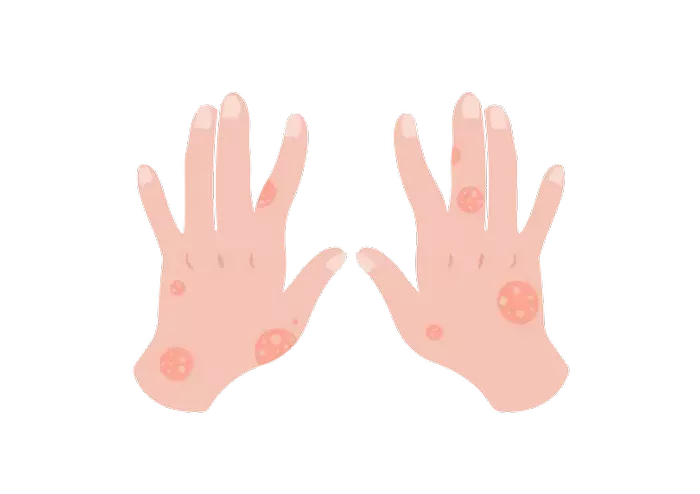Hidradenitis Suppurativa (HS) is a chronic skin condition that significantly impacts the lives of those affected. It manifests as painful lumps, abscesses, and tunnels under the skin, predominantly in areas where skin rubs together, such as the armpits, groin, and buttocks. Despite its prevalence, HS remains a relatively misunderstood condition, and its exact origins are still not entirely clear. This article will explore what is known about the causes of HS, including genetic predisposition, hormonal factors, immune system dysfunction, and environmental triggers. We will also discuss the gaps in current knowledge and ongoing research efforts.
Definition of Hidradenitis Suppurativa (HS)
Hidradenitis Suppurativa (HS) is a chronic inflammatory skin condition characterized by the recurrent formation of painful, boil-like lumps, abscesses, and sinus tracts (tunnels under the skin). These lesions often appear in areas where skin rubs together, such as the armpits, groin, buttocks, and under the breasts. Unlike common acne, HS lesions can be deep and result in significant scarring. The condition is often mistaken for other skin conditions, such as boils or infections, but it is distinct in its chronic nature and tendency to recur.
HS is more than just a skin condition; it is a systemic disease that can have a profound impact on a person’s quality of life. The pain, discomfort, and scarring associated with HS can lead to physical and emotional distress, making it essential to understand its underlying causes and potential treatments.
Known Causes
Understanding the causes of HS is crucial for developing effective treatments and management strategies. While the exact origins of HS are still being researched, several factors are known to contribute to its development.
SEE ALSO: Is Hidradenitis Suppurativa Curable?
Genetic Predisposition
One of the most significant factors in the development of HS is genetics. Research has shown that HS has a strong hereditary component, meaning it tends to run in families. Studies have identified specific genetic mutations associated with HS, particularly those involved in the Notch signaling pathway, which plays a crucial role in cell communication and skin development. Individuals with a family history of HS are at a higher risk of developing the condition, suggesting that genetics play a vital role in its onset.
Hormonal Factors
Hormones, particularly androgens (male hormones present in both men and women), are believed to play a significant role in HS. The condition often begins after puberty and can worsen during times of hormonal fluctuation, such as menstruation or pregnancy. Androgens are known to influence the activity of sebaceous glands and hair follicles, which are often involved in the formation of HS lesions. The exact mechanism by which hormones contribute to HS is still being studied, but their role in the disease’s progression is well recognized.
Immune System Dysfunction
HS is considered an autoinflammatory condition, meaning it involves an abnormal response of the immune system. In individuals with HS, the immune system appears to overreact to minor injuries or blockages in hair follicles, leading to excessive inflammation. This chronic inflammation causes the formation of painful lumps, abscesses, and tunnels under the skin. The immune system’s role in HS is complex, and ongoing research is focused on understanding how immune dysregulation contributes to the condition and how it can be targeted for treatment.
Environmental Triggers
While genetics, hormones, and immune system dysfunction are key factors in HS, environmental triggers also play a role in its development. Factors such as friction, sweating, and obesity are known to exacerbate HS symptoms. For example, friction in areas where skin rubs together can lead to the formation of HS lesions. Obesity is also a significant risk factor, as it increases skin folds and friction, creating an environment conducive to HS. However, the exact role of these environmental triggers in causing HS is still not fully understood, and more research is needed to determine their impact.
Research Efforts
Ongoing research is critical to advancing our understanding of HS and improving the lives of those affected by the condition. Scientists are actively studying the genetic mutations associated with HS, the role of hormones in its development, and the immune system’s contribution to the disease. Clinical trials are also underway to test new treatments that target specific aspects of HS, such as inflammation and immune dysregulation.
For example, biologic therapies that target specific components of the immune system, such as tumor necrosis factor (TNF) inhibitors, have shown promise in treating HS. These treatments work by reducing inflammation and preventing the formation of new lesions. Additionally, researchers are exploring the potential of other immune-modulating therapies and investigating the impact of lifestyle factors, such as diet and weight management, on HS.
Resources and Next Steps
If you or someone you know is affected by HS, it is essential to seek information from reputable sources and consult with a healthcare professional for personalized advice. The following organizations provide valuable resources and support for individuals with HS:
Hidradenitis Suppurativa Foundation
National Institutes of Health (NIH)
By staying informed and working closely with a dermatologist or healthcare provider, individuals with HS can take proactive steps to manage their condition and improve their quality of life.
Conclusion
Hidradenitis Suppurativa (HS) is a complex and challenging condition with multiple contributing factors. While significant progress has been made in understanding the genetic, hormonal, immune, and environmental influences on HS, much remains unknown. Ongoing research efforts offer hope for more effective treatments and a better understanding of this debilitating condition. In the meantime, individuals with HS are encouraged to seek support from healthcare professionals and reputable organizations dedicated to improving the lives of those affected by this condition.
Related Topics:

























